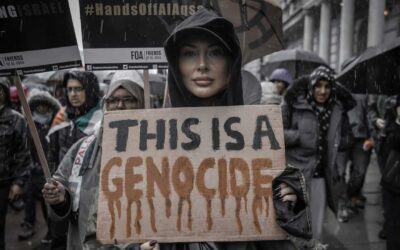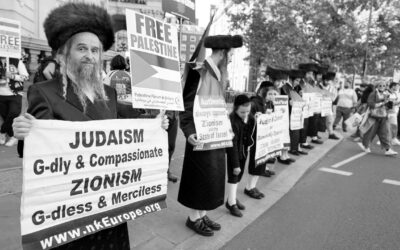Reports have persisted since the first days of the war in Iraq that the U.S. has used napalm against resistance forces. It appeared that the reports were confirmed when the commander of Marine Air Group 11, Col. Randolph Alles, in an interview in 2003, described the use of incendiary bombs in the first months of the war against bridges over the Saddam Canal and the Tigris River, saying “We napalmed both those approaches. Unfortunately, there were people there because you could see them in the [cockpit] video. They were Iraqi soldiers there. It’s no great way to die.”[1]
But to this day the Pentagon denies that is has ever used napalm in Iraq. Technically, the targets Col. Alles spoke of weren’t “napalmed”, the Pentagon has assured us. They were “firebombed”. It wasn’t napalm that was being used, we were told, but “Mark 77 firebombs”, or MK-77 munitions. So why would Col. Alles say the approaches were “napalmed”? An information sheet from the Pentagon explained that “Many folks refer to the Mark 77 as ‘napalm’ because its effect upon the target is remarkably similar.”[2]
“The generals love napalm,” explained Col. Alles, referring to the MK-77 munitions. “It has a big psychological effect.”[3]
Such statements are reminiscent of Winston Churchill’s advocacy of using poisoned gas against Iraqis when they had similarly risen up to kick out their British occupiers. “I do not understand this squeamishness about the use of gas… I am strongly in favor of using poisoned gas against uncivilized tribes,” Churchill said, adding that the use of gas would produce “a lively terror”.[4]
Mark 77 firebombs no doubt also produce a lively terror, as Col. Alles has suggested. And the distinction between “napalm” and the Mark 77 “firebomb”, often ignored even by those who use it, would plainly be lost upon any of the weapon’s victims.
In fact, the only place where the distinction doesn’t seem lost is the Pentagon press room. A fact sheet on the weapons on the Federation of American Scientists website explains that “A fire bomb is a thin skinned container of fuel gel” and describes the MK-77 as “a napalm canister munition” from the family of incendiary bombs infamously used in Korea and Vietnam.[5] It is a weapon of mass terror, and, by definition, a chemical weapon.
The Chemical Weapons Convention (CWC) Treaty, to which the U.S. is a party, defines “Chemical Weapons” to include “Munitions and devices, specifically designed to cause death or other harm through the toxic properties of those toxic chemicals…which would be released as a result of the employment of such munitions and devices”. A “Toxic Chemical” is “Any chemical which through its chemical action on life processes can case death, temporary incapacitation or permanent harm to humans or animals.”[6]
Firebombs, a chemical concoction certainly capable of causing death, incapacitation, or permanent harm, would certainly seem to fit that definition. But the U.S. denies that they are a chemical weapon, defining them instead as “incendiary”.
The Geneva Protocol on Prohibitions or Restrictions on the Use of Incendiary Weapons, or Protocol III of the Convention on Certain Conventional Weapons, defines an “Incendiary weapon” as “any weapon or munition which is primarily designed to set fire to objects or to cause burn injury to persons though the action of flame, heat, or combination thereof, produced by a chemical reaction of a substance delivered on the target.”[7]
Both kinds of weapons kill as the result of a chemical reaction. In that sense, incendiary weapons are also chemical weapons. The distinction, apparently, between a “chemical weapon” and an “incendiary weapon” is that one kills through its toxicity while the other simply incinerates its victims.
This, too, is undoubtedly a distinction lost upon the victims of either kind of weapon.
Subsequently, reports began to emerge of another kind of weapon being used by U.S. forces in Iraq. White phosphorous (WP) is also classified as an incendiary munition, and is used for signaling, for illumination, or to create a smokescreen. It ignites when it is exposed to oxygen, and the chemical reaction continues until it is either consumed or deprived of oxygen. A fact sheet on white phosphorus from GlobalSecurity.org explains that, if used against humans, it “results in painful chemical burn injuries… These weapons are particularly nasty because white phosphorus continues to burn until it disappears. If service members are hit by pieces of white phosphorus, it could burn right down to the bone.”[8] Presumably, it has the same effect on civilians.
White phosphorus, used as a weapon, easily falls into the definition of a chemical “which through its chemical action on life processes can case death, temporary incapacitation or permanent harm to humans or animals”, and therefore a banned chemical weapon under the CWC.
The CWC is monitored by the Organisation for the Prohibition of Chemical Weapons. When asked whether white phosphorus was banned under the treaty, a spokesman for the group said (emphasis added):
No, it’s not forbidden by the CWC if it is used within the context of a military application which does not require or does not intend to use the toxic properties of white phosphorus. White phosphorus is normally used to produce smoke, to camouflage movement. If that is the purpose for which the white phosphorus is used, then that is considered under the Convention legitimate use. If on the other hand the toxic properties of white phosphorus, the caustic properties, are specifically intended to be used as a weapon, that of course is prohibited, because the way the Convention is structured or the way it is in fact applied, any chemicals used against humans or animals that cause harm or death through the toxic properties of the chemical are considered chemical weapons.[9]
In fact, when Saddam Hussein reportedly used white phosphorus, the Pentagon described it as a chemical weapon. A 1995 Department of Defense document stated: “Iraq has possibly employed phosphorous chemical weapons against the Kurdish population…. During the brutal crackdown that followed the Kurdish uprising, Iraqi forces loyal to President Saddam (Hussein) may have possibly used white phosphorous (WP) chemical weapons against Kurdish rebels….”[10]
Apparently, it is only defined as a “chemical weapon” when used by Saddam Hussein. The Pentagon denies that it is a chemical weapon when the U.S. uses the same weapon.
But the Pentagon does recognize it as an “incendiary” weapon. Under Protocol III of the Convention on Certain Conventional Weapons, “It is prohibited in all circumstances to make the civilian population as such, individual civilians or civilian objects the object of attack by incendiary weapons…. to make any military objective located within a concentration of civilians the object of attack….”[11]
As the Financial Times noted, Protocol III “prohibits the use of incendiary weapons against military forces located within concentrations of civilians – as was the case with the insurgents in Falluja.” But, noted the Financial Times, “The US is party to the convention but, unlike a number of its allies, including the UK, it has not signed Protocol III.”[12]
It’s therefore perfectly “legal”, if one follows the Pentagon’s logic, for white phosphorus and MK-77 firebombs to be used in areas with large concentrations of civilians.
Darrin Mortenson, an embedded journalist in Iraq, reported on the use of the weapon in April, 2004, describing a scene of indiscriminate shelling in Fallujah:
Bogert is a mortar team leader who directed his men to fire round after round of high explosives and white phosphorus charges into the city Friday and Saturday, never knowing what the targets were or what damage the resulting explosions caused…. “Gun up!” Millikin yelled when they finished a few seconds later, grabbing a white phosphorus round from a nearby ammo can and holding it over the tube. “Fire!” Bogert yelled, as Millikin dropped it. The boom kicked dust around the pit as they ran through the drill again and again, sending a mixture of burning white phosphorus and high explosives they call “shake ‘n’ bake” into a cluster of buildings where insurgents have been spotted all week. They say they have never seen what they’ve hit.… Even the battalion surgeon fired a few Saturday, just for sport. Everyone wants to “get some,” the troops explain, some joking that Fallujah is like a live-fire range. Some have started to think of what happens after all the guns go silent. “I just don’t want to come home and have someone call me a baby killer,” Alexander said after firing dozens of high explosive mortar rounds into the city. “That would piss me off.”[13]
Then in November of last year, resistance sources told Al-Quds Press that “The US occupation troops are gassing resistance fighters and confronting them with internationally-banned chemical weapons,” adding that innocent civilians had been killed.[14]
On November 12, the U.S. Department of Defense responded to the allegations, saying, “The United States categorically denies the use of chemical weapons at anytime in Iraq, which includes the ongoing Fallujah operation.”[15]
But the reports persisted. Later that month, independent journalist Dahr Jamail was interviewed by Amy Goodman on Democracy Now! He reported:
I have interviewed many refugees over the last week coming out of Fallujah at different times from different locations within the city. The consistent stories that I have been getting have been refugees describing phosphorus weapons, horribly burned bodies, fires that burn on people when they touch these weapons, and they are unable to extinguish the fires even after dumping large amounts of water on the people.
He described the effects as being “very similar to napalm”.[16]
The reports persisted. In January, 2005, the U.S. State Department responded by issuing a statement saying that “The fighting in Fallujah, Iraq has led to a number of widespread myths including false charges that the United States is using chemical weapons such as napalm and poison gas. None of these allegations are true.” The statement, however, acknowledged that “Mark-77 firebombs, which have a similar effect to napalm, were used against enemy positions in 2003”, but denied that they were used in Fallujah. “Napalm is a gel, not a gas”, the statement added. Furthermore, “Phosphorus shells are not outlawed. U.S. forces have used them very sparingly in Fallujah, for illumination purposes. They were fired into the air to illuminate enemy positions at night, not at enemy fighters.”[17]
But several months later, the Army’s Field Artillery magazine published an article entitled “The Fight for Fallujah”, which stated:
WP [white phosphorus] proved to be an effective and versatile munition. We used it for screening missions at two breeches and, later in the fight, as a potent psychological weapon against the insurgents in trench lines and spider holes when we could not get effects on them with HE [high explosives]. We fired “shake and bake” missions at the insurgents, using WP to flush them out and HE to take them out.[18]
In Britain, Defence minister Adam Ingram had answered persistent reports of the use of napalm by assuring Parliament that the U.S. was not using the weapons. In December 2004, he responded to the question of whether “napalm or a similar substance has been used by the coalition” (emphasis added) by saying, “No napalm has been used by coalition forces in Iraq either during the war-fighting phase or since.”[19]
But after the evidence of the use of a weapon “remarkably similar” to napalm became undeniable, he claimed that he had been misinformed by the U.S. “The US confirmed to my officials that they had not used MK77s in Iraq at any time and this was the basis of my response to you,” he said, adding, “I regret to say that I have since discovered that this is not the case and must now correct the position.”[20]
The U.S. Ambassador to London, Robert Tuttle similarly denied that white phosphorus was used as a weapon: “US forces participating in Operation Iraqi Freedom continue to use appropriate lawful conventional weapons against legitimate targets. US forces do not use napalm or white phosphorus as weapons.”[21]
Then, earlier this month, on November 8, RAI, an Italian state-run TV station, broadcast a documentary accusing the U.S. of using white phosphorus bombs in Fallujah, alleging that civilians were killed by the incendiary munitions. An American soldier interviewed for the documentary said, “I heard the order to pay attention because they were going to use white phosphorus on Fallujah. In military jargon it’s known as Willy Pete. Phosphorus burns bodies, in fact it melts the flesh all the way down to the bone…. I saw the burned bodies of women and children.”[22]
The report re-kindled the furor over the use of weapons banned by international treaties. The Pentagon responded by assuring that white phosphorus “was not used against civilians”, but acknowledged that it was used as a weapon against “enemy combatants”. The State Department, which had said the munitions had been used only “to illuminate enemy positions”, had to back away from their previous statement. “There is a great deal of misinformation feeding on itself about U.S. forces allegedly using ‘outlawed’ weapons in Fallujah,” the department said. “The facts are that U.S. forces are not using any illegal weapons in Fallujah or anywhere else in Iraq.”[23]
“White phosphorus is a conventional munition,” a Pentagon spokesman assured us. “It is not a chemical weapon. They are not outlawed or illegal. We use them primarily as obscurants, for smokescreens or target marking in some cases. However, it is an incendiary weapon and may be used against enemy combatants.” Asked whether white phosphorus was used as an offensive weapon in Fallujah, he answered, “Yes, it was used as an incendiary weapon against enemy combatants.”[24] When asked if it was possible that civilians had been killed by the weapon, he replied, “It would not be out of the realm of the possible.”[25]
“It’s perfectly legitimate to use this stuff against enemy combatants,” he declared.[26]
The New York Times ran to the Pentagon’s defense, saying that the RAI documentary “incorrectly referred to white phosphorus shells – a munition of nearly every military commonly used to create smoke screens or fires – as banned chemical weapons.” The Times’ only criticism seems to be that, as the headline of the article suggests, the “U.S. Is Slow to Respond to Phosphorus Charges”. While the State Department would give no comment, an official told the Times privately “that the episode was a public relations failure.”[27]
This message is instructive. The use of firebombs “remarkably similar” to napalm is perfectly “legal”, and the use of white phosphorus as a weapon is totally “legitimate”. And if anyone thinks otherwise, it’s only due to a “public relations failure”. The Pentagon just has not done a good enough job of defending its use of these weapons against baseless propaganda, if we interpret the message correctly; that is, as we are supposed to. Nothing to see here. Move along.
Let us seek to assure that the final word in the matter comes not from the Pentagon, or from the media sources that parrot Pentagon proclamations without any serious analysis, but from the victims in Iraq who have suffered or been killed as a result of not only the U.S. decision to wage a war of aggression, but also the continued use such indiscriminate weapons as cluster munitions, depleted uranium, napalm, and white phosphorus—all, by any measure, weapons of mass destruction.
[1] James W. Crawley, “Officials confirm dropping firebombs on Iraqi troops”, San Diego Union-Tribune, August 5, 2003
https://www.signonsandiego.com/news/military/20030805-9999_1n5bomb.html
[2] James W. Crawley
[3] James W. Crawley
[4] “Winston Churchill’s Secret Poison Gas Memo”, Centre for Research on Globalisation, July 29, 2004
https://globalresearch.ca/articles/CHU407A.html
[5] MK-77 Fire Bombs Fact Sheet, Federation of American Scientists
https://www.fas.org/man/dod-101/sys/dumb/mk77.htm
[6] Chemical Weapons Convention Treaty
https://www.cwc.gov/treaty/treatytext_html
[7] Protocol on Prohibitions or Restricitons on the Use of Incendiary Weapons (Protocol III), Convention on Certain Conventional Weapons, Geneva, October 10, 1980
https://www.icrc.org/ihl.nsf/FULL/515?OpenDocument
[8] “White Phosphorous” Fact Sheet from GlobalSecurity.org
https://www.globalsecurity.org/military/systems/munitions/wp.htm
[9] Paul Reynolds, “White phosphorus: weapon on the edge”, BBC, November 16, 2005
https://news.bbc.co.uk/1/hi/world/americas/4442988.stm
[10] “Possible Use of Phosphorous Chemical Weapons by Iraq”, Department of Defense, 1995
https://www.fas.org/irp/gulf/intel/950901/22431050_91r.txt
https://www.gulflink.osd.mil/declassdocs/dia/19950901/950901_22431050_91r.html
[11] Protocol on Prohibitions or Restricitons on the Use of Incendiary Weapons
[12] Guy Dinmore, “Phosphorous ‘may have killed’ in Iraq”, Financial Times, November 16, 2005
https://news.ft.com/cms/s/5fc7a7b4-56f9-11da-b98c-00000e25118c.html
[13] Darrin Mortenson, “Violence subsides for Marines in Fallujah”, North County Times, April 10, 2004
https://www.nctimes.com/articles/2004/04/11/military/iraq/19_30_504_10_04.txt
[14] “US Troops Reportedly Gassing Fallujah”, Islam Online, November 10, 2004
https://www.islamonline.org/English/News/2004-11/10/article05.shtml
[15] “Did the U.S. Use ‘Illegal’ Weapons in Fallujah?”, U.S. State Department, January 27, 2005
https://www.globalsecurity.org/military/library/report/2005/050127-fallujah.htm
[16] “U.S. Accused of Using Poison Gases in Fallujah”, Democracy Now!, November 29, 2004
https://www.democracynow.org/article.pl?sid=04/11/29/1448226
[17] “Did the U.S. Use ‘Illegal’ Weapons in Fallujah?”
[18] “The Fight for Fallujah”, Field Artillery, March-April 2005
https://sill-www.army.mil/FAMAG/Previous_Editions/05/mar-apr05/PAGE24-30.pdf
[19] George Monbiot, “The US Used Chemical Weapons in Iraq – And Then Lied About It”, The Guardian, November 15, 2005
https://www.guardian.co.uk/Columnists/Column/0,5673,1642831,00.html
[20] Colin Brown, “US Lied to Britain Over Use of Napalm in Iraq War”, The Independent, June 17, 2005
https://news.independent.co.uk/uk/politics/story.jsp?story=647397
[21] Jamie Wilson, “US admits using white phosphorous in Falluja”, The Guardian, November 16, 2005
www.guardian.co.uk/Iraq/Story/0,2763,1643680,00.html
[22] Peter Popham, “US forces ‘used chemical weapons’ during assault on city of Fallujah”, The Independent, November 8, 2005
https://news.independent.co.uk/world/middle_east/article325560.ece
[23] Robert Burns, “Pentagon used white phosphorous in Iraq”, Associated Press, November 15, 2005
https://www.washingtonpost.com/wp-dyn/content/article/2005/11/15/AR2005111501210_pf.html
[24] “Pentagon confirms using white phosphorous in Iraq”, Agence France Presse, November 15, 2005
https://news.yahoo.com/s/afp/20051115/pl_afp/usiraqbritainitaly
Jamie Wilson, “US admits using white phosphorous in Falluja”, The Guardian, November 16, 2005
www.guardian.co.uk/Iraq/Story/0,2763,1643680,00.html
[25] Guy Dinmore, “Phosphorous ‘may have killed’ in Iraq”, Financial Times, November 16, 2005
https://news.ft.com/cms/s/5fc7a7b4-56f9-11da-b98c-00000e25118c.html
[26] Scott Shane, “U.S. Is Slow to Respond to Phosphorus Charges”, The New York Times, November 21, 2005
[27] Scott Shane


